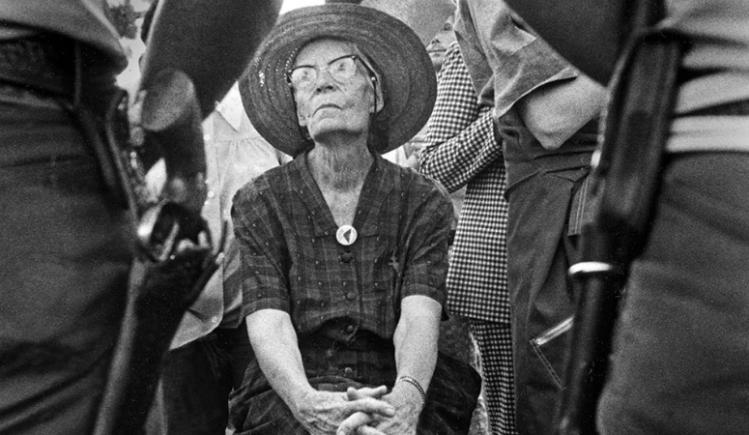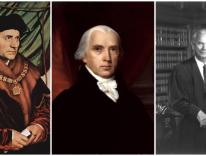
I first discovered Dorothy Day when, in college, one of my best friends from high school responded to my increasing infatuation with Thomas Merton by sending me The Long Loneliness. Merton’s combination of contemplation and social commentary seemed much more attractive to me at the time. So did his affinities for Buddhism, making him (and me) a good fit for the pluralistic culture of my college. But over time, I became much more taken with Dorothy Day. She is more difficult, challenging, and powerful. Today, when I read Merton’s journals, his long struggles with his vocation, born of understandable frustration with the leadership of Gethsemane Abbey, and his retreat to his hermitage remind me too much of the escape fantasies produced by routine battles of academic life. When I read Dorothy Day’s journals, I am struck by something different: a relentless dedication in the face of every challenge—a total refusal to retreat and a remarkable lack of bitterness. Nearly every page of her journals testifies to her commitment to live the Gospel where she already is, and to discover joy there.
This juxtaposition of personalities is appropriate, because one of Day’s great gifts—and one of the best things about Patrick Jordan’s new biography of her, in Liturgical Press’s People of God series—is her unexpected and ever-challenging personality. Jordan, a longtime Commonweal editor, writes as one who knew her well, and so the book is able to convey a vivid sense of Day as a person. The Day we meet had a remarkable ability to be attentive to everyone she met and to the beauty appearing in ordinary life. Yet she could also be “short, overbearing or even cantankerous.” She possessed a kind of worldliness that enabled her to accept all things with mercy and love, but also a severity of perspective, never more severe than when she trained it on herself. She was a person who loved as few have loved, and yet, Jordan writes, “in a very real sense, she remained a single, solitary figure.”
Jordan brings an ease to his subject that comes from genuine friendship—it has the honesty of a companion, not that of a reporter. His book is not hagiography, but neither does it pretend to an objective distance. He remarks on the first page, “She was delightfully down-to-earth and a pleasure to be with—most of the time.” Such a remark, combining knowing and heartfelt praise with a gentle poke, typifies the book.
It isn’t only Jordan’s tone that hits the mark. Instead of offering a chronological narrative, he weaves together his living sense of Day’s personality with some of the major themes of her work. The result is illuminating, even for those who already know a lot about Day. Jordan includes not only what you might call “Day’s Greatest Hits” but a wide set of lesser-known insights and episodes from her diaries, letters, archives, and acquaintances. Still, the book’s very brevity requires him to focus on the essential—on what mattered most to her, and about her.
And what was that? In a closing chapter on Day’s candidacy for sainthood, Jordan calls her “a complex, compelling, and sometimes contradictory person,” and these qualities made her a “real” rather than a “plaster” saint. Jordan’s biography draws attention to three aspects of Day’s life that, taken together, make it impossible to understand her either as a standard-issue social-justice activist or as just another libertine-turned-ascetic on the model of St. Augustine. She was not reducible to any Catholic stereotype.
First, Day’s love of others, the poor, and the church was remarkably lacking in sentimentality. Jordan quotes her saying she “cannot bear the religious romantics,” preferring a realism that “prays to see things as they are and to do something about it.” Too often, we are presented with a false choice between a tug on the heartstrings and a presumably hard-nosed realism. Tough and tender are treated as opposites, even in terms of ecclesial style—for example, in the frequently drawn contrast between Popes Benedict and Francis. Day combined toughness and tenderness, giving us a compelling example of the challenges of real mercy. Her toughness began with a stringent self-awareness: “I see only too clearly how bad people are,” she said. “I wish I did not see it. It is my own sins that give me such clarity.” Jordan writes that Day was “the most self-reflective and consistently self-aware person I have known.”
The same lack of sentimentality was related to a second unusual quality: Day’s ability to communicate love and attention to all, even to those with whom she had clear disagreements. Jordan often describes Day as “inclusive” and illustrates this quality with a story of a Catholic Worker who enlisted in World War II, fought bravely, and—despite Day’s consistent pacifism—was encouraged to rejoin the Catholic Worker community afterward. He went on to become “a mainstay of the movement” before becoming a Trappist monk. The story is remarkable in an age of blog and Twitter “flamewars,” in which strong commitments like Day’s pacifism invariably come with a desire to castigate and expel those who are unfaithful to the cause. Too often, being “inclusive” can seem to require an abandonment of strong principle. For Day, it did not. Jordan emphasizes her principled respect for conscience, but she also seems to have been able to imagine a Catholic Church in which forthright disagreement did not require anathemas or schisms—a characteristic especially apparent in her ability to combine both charitable respect for bishops and vocal disagreement with them.
That brings us to a third remarkable trait: Day’s life was guided by firm principle and animated by an extraordinarily deep passion. As a 1969 profile of Day put it, her daily life embodied “the truth of a love that categorically refused to deny the irreducible humanity in every talking creature.” This makes it sound like a bloodless doctrine, but Jordan notes a diary entry from the same year in which Day compares her experiences at the Catholic Worker to “falling in love,” a “quality of in-loveness that may brush like a sweet fragrance,” a feeling that “may be an intuition of immortality.” Many of the stories about Day in this book reflect a level of Catholic learning that is almost miraculous, given her lack of any formal Catholic education and her lifetime of daily activism. Where did she learn all this spiritual wisdom? More to the point, how did she manage to embody it with a practical immediacy most of us can’t match? In another remarkable diary entry, Day attempts to sum up the Catholic Worker, noting that some say it is about peace, while others “go deeper” and see the mystery of voluntary poverty and still others move beyond that to a recognition of the profound trust in Providence that voluntary poverty requires. But finally, she says, “love is the reason for it all.” There is a simplicity and a fierceness about this passage that almost embarrasses me as an academic theologian. In Day, piercing intellect and passionate practicality build on each other.
JORDAN SHEDS some light on these three aspects of Day’s life when he writes about her sense of certainty about her vocation. It was not the sort of certainty that sought to lord it over others or to bully them. But, as Jordan indicates, Day herself never seems to have been in serious doubt about her mission—her struggles had to do with how to carry it out. Such a sense of stability looks more and more remarkable in the context of a culture that celebrates, or at least accepts, perpetual transition. In an era when people are expected to cycle through many careers and even many selves, Day’s example is compelling precisely because, once she found her calling, she stuck to it, even as many others in the Catholic Worker movement came and went. Day thus exemplifies the virtue of “sobriety” as Pope Francis describes it in Laudato si’: people with this kind of spiritual sobriety are not “dipping here and there, always on the lookout for what they do not have”; instead, they live out the conviction that “less is more” and “experience what it means to appreciate each person and each thing.”
Day’s own ideas, grounded both in her activist background and in the “personalist communitarianism” of Peter Maurin, continue to challenge the tendencies of both conservative and progressive Catholics. She was critical of usury, pacifist even during “the good war,” skeptical of government welfare programs, averse to institutionalizing the Catholic Worker, and insistent on the importance of personal responsibility. Jordan quotes something she wrote in 1969: “Necessary for people to change. Quit worrying about popes, cardinals, bishops, structures, institutions.” The statement “we begin with ourselves” appears twice in the book.
Jordan, whose voice remains admirably muted throughout, concludes by suggesting that Day be seen as an “American prophet”—with prophecy understood not only as offering an urgent message but also as embodying a whole “way of being in the world.” Day’s prophetic message, Jordan writes, sought “a closing of the gap between private and public morality…and questioned both our materialism and militarism.” She was, he concludes, “someone who kept pushing us.” But Jordan’s biography also suggests why Dorothy’s significance is not reducible to the Catholic Worker program: she succeeds in pushing even those whom she does not entirely persuade. Her real significance is to challenge us at a level more fundamental than policy. One is tempted to call it “holiness” even though that word, so easily misunderstood, may make her sound like a “sacristry Christian.” It should instead indicate her willingness to treat as a daily imperative what most of us treat as a noble but impractical ideal: seeing Christ in all others, affirming their dignity with every fiber of one’s being, and living totally for God. Jordan’s book is a very fine introduction to Day’s life and work, and an outstanding reminder of the challenge she still poses to Catholics everywhere. It helps us understand why she was one of the two American Catholics Pope Francis cited last year in his address to Congress. The other? Thomas Merton.
Please email comments to [email protected] and join the conversation on our Facebook page.
Previous Story
A Distinction without a Difference?
Next Story
An Interview with Former CIA Analyst Ray McGovern


